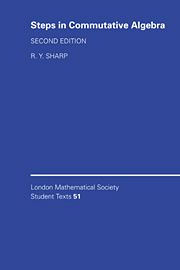Book contents
- Frontmatter
- Contents
- Preface to the 1st Edition
- Preface to the 2nd Edition
- 1 Commutative rings and subrings
- 2 Ideals
- 3 Prime ideals and maximal ideals
- 4 Primary decomposition
- 5 Rings of fractions
- 6 Modules
- 7 Chain conditions on modules
- 8 Commutative Noetherian rings
- 9 More module theory
- 10 Modules over principal ideal domains
- 11 Canonical forms for square matrices
- 12 Some applications to field theory
- 13 Integral dependence on subrings
- 14 Afflne algebras over fields
- 15 Dimension theory
- 16 Regular sequences and grade
- 17 Cohen–Macaulay rings
- Bibliography
- Index
Preface to the 1st Edition
Published online by Cambridge University Press: 06 January 2010
- Frontmatter
- Contents
- Preface to the 1st Edition
- Preface to the 2nd Edition
- 1 Commutative rings and subrings
- 2 Ideals
- 3 Prime ideals and maximal ideals
- 4 Primary decomposition
- 5 Rings of fractions
- 6 Modules
- 7 Chain conditions on modules
- 8 Commutative Noetherian rings
- 9 More module theory
- 10 Modules over principal ideal domains
- 11 Canonical forms for square matrices
- 12 Some applications to field theory
- 13 Integral dependence on subrings
- 14 Afflne algebras over fields
- 15 Dimension theory
- 16 Regular sequences and grade
- 17 Cohen–Macaulay rings
- Bibliography
- Index
Summary
Why write another introductory book on commutative algebra? As there are so many good books already available on the subject, that seems to be a very pertinent question.
This book has been written to try to persuade more young people to study commutative algebra by providing ‘stepping stones’ to help them into the subject. Many of the existing books on commutative algebra, such as M. F. Atiyah's and I. G. Macdonald's [1] and H. Matsumura's [13], require a level of experience and sophistication on the part of the reader which is rather beyond what is achieved nowadays in a mathematics undergraduate degree course at some British universities. This is sad, for students often find some undergraduate topics in ring theory, such as unique factorization in Euclidean domains, attractive, but this undergraduate study does leave something of a gap which needs to be bridged before the student can approach the established books on commutative algebra with confidence. This is an attempt to help to bridge that gap.
For definiteness, I have assumed that the reader's knowledge of commutative ring theory is limited to the contents of the book ‘Rings and factorization’ [20] by my colleague David Sharpe. Thus the typical reader I have had in mind while writing this book would be either a final year undergraduate or first year postgraduate student at a British university whose appetite for commutative ring theory has been whetted by a course like that provided by [20], but whose experience (apart from some basic linear algebra and vector space theory) does not reach much beyond that.
- Type
- Chapter
- Information
- Steps in Commutative Algebra , pp. ix - xiPublisher: Cambridge University PressPrint publication year: 2001



